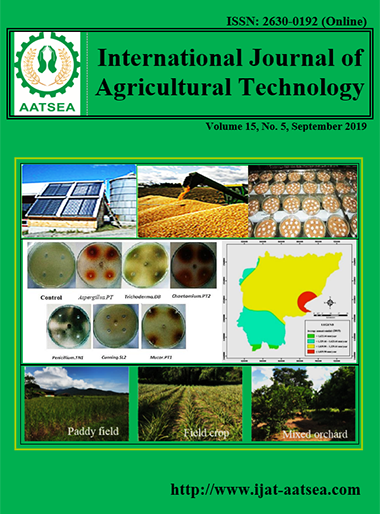Salt tolerance evaluation in guava germplasm
Main Article Content
Abstract
The five-month-old plants obtained from stem-cutting of 20 guava genotypes were grown in sand culture with 200 mM NaCl for 19 days to evaluate their salt tolerance. The primary symptom of salt stress, leaf burn, appeared from the young to the mature and from the margin to the center of leaves in all genotypes were reported. Based on leaf burn severity, the 20 guava genotypes were separated into four groups by level of tolerance. One genotype (KUHP38) was highly tolerant, three genotypes (‘Paen Seethong’, ‘Na Suan’, and KUHP12) were moderately tolerant, eight genotypes were sensitive, and eight genotypes were highly sensitive to salt stress. The highly tolerant genotype showed high survival and slight leaf burn, while the highly sensitive genotypes showed severe leaf burn and even death of some plants. Sodium and chloride content in the leaves, stems, and roots of the highly sensitive genotype was higher than in the highly tolerant genotype. Based on the results obtained, ‘Paen Seethong’ and ‘Na Suan’ were recommended for desert-type commercial plantings in the saline soil regions of Thailand, while KUHP38 and KUHP12 may be used as rootstocks. These genotypes could be used as breeding materials for developing new cultivars with high salt tolerance.
Article Details

This work is licensed under a Creative Commons Attribution-NonCommercial-NoDerivatives 4.0 International License.
References
Ebert, G., Eberle, J., Ali-Dinar, H. and Ludders, P. (2002). Ameliorating effects of Ca(NO3)2 on growth, mineral uptake and photosynthesis of NaCl-stressed guava seedlings (Psidium guajava L.). Scientia Horticulturae, 93: 125-135.
Im-Erb, R., Neawsuparb, K. and Sombatpanit, S. (2013). Soil Salinization Assessment and Monitoring at BoeKlue District, Nan Province, Northern Thailand. In: Shahid, S.A., Abdelfattah, M.A. and Taha, F.K., eds. Developments in Soil Salinity Assessment and Reclamation: Innovative Thinking and Use of Marginal Soil and Water Resources in Irrigated Agriculture, Springer Science+Business Media, Dordrecht, pp. 75-86.
Ghassemi, F., Jakeman, A.J. and Nix, H.A. (1995). Salinisation of Land and Water Resources: Human Causes, Extent, Management and Case Study. CAB International, Wallingford, UK, pp. 526.
Maas, E.V. (1993). Testing crops for salinity tolerance. Proc. Workshop on Adaptation of Plants to Soil Stresses. Lincoln, NE, pp. 234-247.
Okubo, M. and Sakuratani, T. (2000). Effects of sodium chloride on survival and stem elongation of two Asian pear rootstock seedlings. Scientia Horticulturae, 85: 85-90.
Orcutt, D.M. and Nilsen, E.T. (2000). Physiology of Plants Under Stress: Soil and Biotic Factors. John Wiley & Sons, New York, pp. 696.
Ruiz, D., Martinez, V. and Cerda, A. (1999). Demarcating specific ion (NaCl, Cl-, Na+) and osmotic effects in the response of two citrus rootstocks to salinity. Scientia Horticulturae, 80: 213-224.
Thaipong, K. and Boonprakob, U. (2006). Repeatability, optimal sample size of measurement and phenotypic correlations of quantitative traits in guava. Kasetsart Journal (Natural Science), 40: 11-19.
Thaipong, K., Promchot, S., Auvuchanon, A. and Boonprakob, U. (2017). Genetic analysis of guava germplasm using AFLP markers. International Journal of Agricultural Technology, 13: 741-752.


